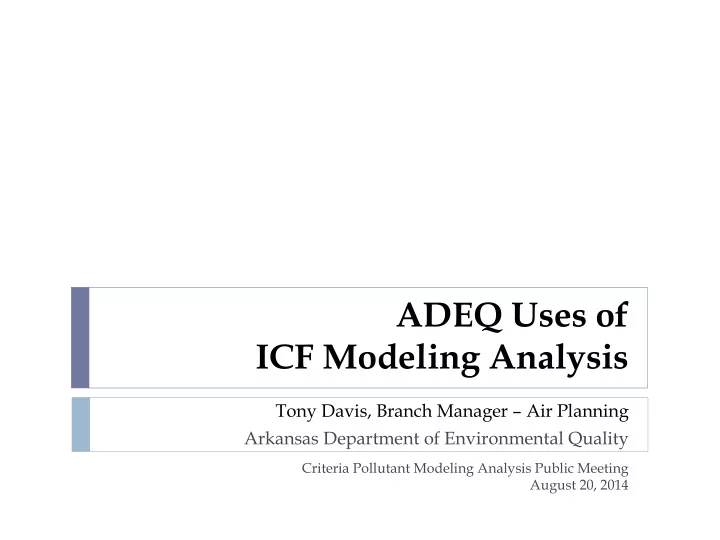

ADEQ Uses of ICF Modeling Analysis Tony Davis, Branch Manager – Air Planning Arkansas Department of Environmental Quality Criteria Pollutant Modeling Analysis Public Meeting August 20, 2014
ADEQ Uses of ICF Analysis Communication of air quality in unmonitored areas
Annual Network Plan (ANP) Any modifications to the monitoring network will need to be cited in the ANP Submitted annually by July 1 to EPA Region 6
5-Year Network Assessment More detailed then the ANP Submitted to EPA Region 6 every 5 years The 2015 Network Assessment will be useful in designing the monitoring network for years 2016 to 2020 Changes to the network are also cited in the ANP
Urban Areas and Transportation Corridors are Large Contributors to NO 2 Concentrations
Oil and Gas Exploration activities in the Fayetteville Shale Play may be a significant source of criteria pollutant emissions that is likely underestimated in current emission inventories. The Arkansas Oil and Gas Commission has issued over 9,000 permits for exploration wells and associated activities.
Future 8-Hour ozone concentrations show progress but more may be needed if the ozone NAAQS is revised to a more stringent level.
Seasonally high concentrations of PM 2.5 have a large influence on the annual standard
SO 2 emissions from fuel combustion at power plants should be significantly reduced by current and future federal regulatory programs. Source-oriented monitoring may be required at some of these facilities.
Examples of Emission Source Categories EGU Point – electric generation facilities burning coal, oil, natural gas Non-EGU Point – other large industrial facilities (stacks, flares, fugitives) Non-Point Area – dry cleaners, gas stations, auto body paint shops, Non-Road - ships, planes, agricultural and construction equipment On-Road Mobile – cars, trucks, buses, motorcycles Biogenic – fires, trees, vegetation
Arkansas PM 2.5 Emissions from ICF Analysis 2008 Base Year PM 2.5 2015 Future Year PM 2.5 (thousand tpy) Emissions (thousand tpy) Emissions 12 11 6 8 17 10 21 32 166 197 EGU Point Non-EGU Point Non-Point Area EGU Point Non-EGU Point Non-Point Area Non-Road On-Road Mobile Non-Road On-Road Mobile
Arkansas SO 2 Emissions from ICF Analysis 2008 Base Year SO 2 2015 Future Year SO 2 (thousand tpy) Emissions (thousand tpy) Emissions 0 0 2 1 5 27 14 12 102 72 EGU Point Non-EGU Point Non-Point Area EGU Point Non-EGU Point Non-Point Area Non-Road On-Road Mobile Non-Road On-Road Mobile Increased SO2 emissions in EGU Point category are from estimated growth in energy demand from EGUs. Reason for growth in Non-point Area category is unknown.
Emissions Inventory Improvements Currently, ADEQ collects detailed emissions data from Point Sources and uses EPA emission estimates for Area sources. Data for Onroad, Nonroad, Nonpoint, and Event sources is not as robust as data from Point Sources. Future Considerations for Emissions Inventory Improvements might include: Onroad and Nonroad : Collection of local data inputs for each county Nonpoint: Collection of local data and emission estimates for Nonpoint sources Events: Wildland Fires: Collection, analysis, and submittal of prescribed fire and wildfire occurrence data to EPA for use in emissions modeling Agricultural Burning: Conducting surveys of agricultural burning practices in the state to verify EPA inputs for emissions modeling Improved emission inventory data would provide additional insight into which sources are contributing to elevated concentrations of criteria pollutants. This knowledge would provide a better understanding of what emission source types should be the focus of any future emission reduction policies.
Ozone Design Values Historical (2003-2013) and Future Year (2015)* DV 100 90 Violation of Current Standard Ozone Design Value Concentrations (ppb) 80 70 CASAC Recommendation Range 60 Clark and 50 Washington 40 30 20 10 0 * 2003 2004 2005 2006 2007 2008 2009 2010 2011 2012 2013 2014 2015 Clark Co Crittenden Co Newton Co Polk Co Pulaski Co Washington Co * Future Year 2015 estimates from ICF Analysis NOTE: In addition to the primary standard, EPA may propose a secondary standard for the protection of agricultural crops.
Cost of Establishing a Monitoring Site Site Preparation - $8,500 - $11,000 Meter Loop Installation Trailer Equipment - $40,000 Analyzers Calibrators Data Logger Recurring Costs - $1,200/year - $2,750/year Electricity Gas Standards for Equipment Data Logger Communication Land Usage Lease A multi-pollutant (NCORE) site might cost ~ $250,000
ADEQ Uses of ICF Analysis Identification of areas that might require additional monitoring in the absence of facility-specific modeling. Impacts of non-attainment including impacts on health and economy. Comparison of present and future pollutant levels against NAAQS Annual and five year monitoring network review Infrastructure SIP planning and development for both attainment and nonattainment areas Documentation and communication of air quality in unmonitored areas Identification of areas that might be unduly affected by, or sensitive to non- point emissions (fire, transportation, fugitive dust, etc.) Non-point (area source) category identification for SIP development
Questions? Tony Davis Branch Manager, Air Planning Arkansas Department of Environmental Quality (501) 682-0728 davisa@adeq.state.ar.us
Recommend
More recommend